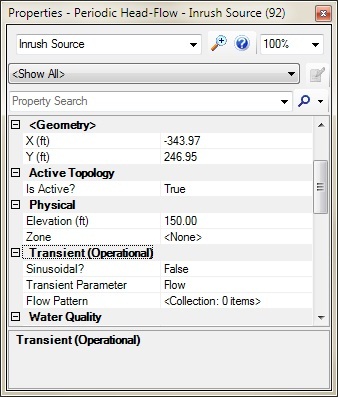| |
Applies To |
|
|
| |
Product(s): |
HAMMER |
|
| |
Version(s): |
CONNECT Edition, V8i |
|
| |
Area: |
Modeling |
|
Problem
How do I model a positive displacement pump (screw pump, lobe pump, sliding vane pump, etc...) for a transient simulation in HAMMER?
Background
HAMMER cannot accurately model a positive displacement pump using the pump element, as the pump element represents a centrifugal pump. Positive displacement pump characteristics are completely different from those used for four-quadrant pump curves used in HAMMER for pumps.
However, it is possible to approximate a positive displacement pump, using a Periodic Head-Flow element.
Solution
First, you would need to externally determine the flow that would occur out of the pump and compile a table of flow versus time. Then you would use two "periodic head-flow" elements in the model, one representing the suction side and one for the discharge side, with a gap between, as shown below.

In the Properties display for the Periodic Head-Flow elements, you would set the attribute "Transient Parameter" to Flow. For "Sinusoidal?", choose False.

This will enable you to define the Flow Pattern table for flow versus time. The tables for each will need to be identical, except that the values for flow. On the suction side, the flow values will be positive (outflow). On the discharge side, they will be negative, to represent inflow. This way, you can approximate the correct flow rates and let the head behave as it should based on the system conditions.
If for example your PD pump is discharging against a valve that closes, you will need to ensure that the Periodic head-flow element accounts for the reduction in flow that occurs as the downstream valve closes. Otherwise if your periodic head-flow element continues trying to force an inflow against a closed valve with no other way for the water to exit, you will see a continuous pressure rise. HAMMER will not know to automatically stop the inflow.
See Also
Help Documentation section: "Positive Displacement Pumps"
Changing or forcing a pattern of hydraulic grade or flow during a transient simulation